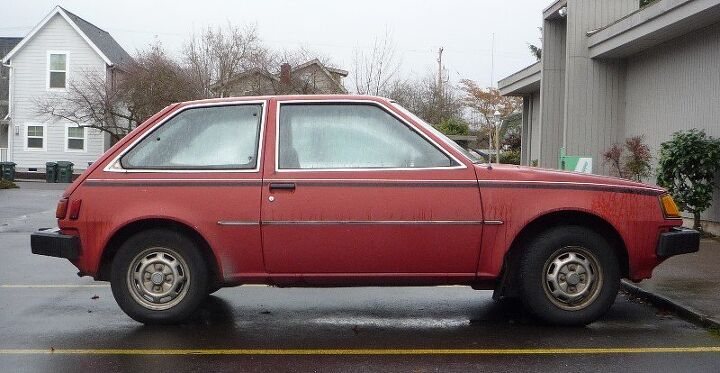Curbside Classic Dead Brands Week: 1983 Plymouth Colt & 1980 Plymouth Champ

Maybe we should change the title to Two Dead Brands At A Time Week. Topping yesterday’s triple knock-out of Rover and Sterling is going to be a challeng(er). But we’re in contention here with this twin name, twin stick, twin cars, twin wipers, twin brands Colt/Champ. Plymouth has undeniably gone to the Dead Brand underworld. And the Colt name became a brand in its own right, covering a huge variety of Mitsubishi-built vehicles from tiny hatches like this to the mini-van Colt Vista Wagon. The fact that Colts were sold by both Dodge and Plymouth seals the deal. Of course, it wasn’t always that simple, as in the case of the Champ. It had its name changed midway through its run to Colt, hence the two versions here. And Mitsubishi is skating on dangerously thin ice itself these days. But beyond the mortality of its name, the real claim to fame of this car is its legendary twin-stick transmission.
Like most affairs of money or heart, the Mitsubishi-Chrysler hook-up had its highs and lows. Given its starting date in 1971, it was precedent-setting, as a number of similar tie-ups between Ford and GM with various Japanese partners soon followed its pattern. Remarkably, Chrysler must have actually seen the writing on the wall in the sixties: that it didn’t have the resources to develop a truly competitive small car. Ford and GM still had the hubris to think they could (Pinto & Vega). So Chrysler went shopping in Japan, and bought a 15% share in Mitsubishi.
It’s not like Chrysler wasn’t building small cars at the time, at its European subsidiaries Rootes and Simca. Exactly what drove Chrysler to not take their European cars seriously, like the very advanced Simca 1204, is hard to say. Maybe they saw the Japanese cars for what they were: out-of-the-box-ready to take on the difficult US conditions unlike their fragile Simcas and Hillmans. Chrysler did import both the Simca and the Hillman (as the ill-fated Plymouth Cricket), but once its relationship with Mitsubishi was sealed, it never looked back. Well, until its own Omni/Horizon.
The Colt story gets very complicated, especially in light of our neighbors to the north. Chrysler has always messed with our heads by flipping around names and badges in Canada, but it gets totally insane with the Mitsubishis. I’m not going to work it all out for all you Canucks here; just go to this article at allpar.com, it’s got the whole mess untangled there. Lets just say they reversed the US naming-craziness, and called Dodges “Champs” and Plymouths “Colts”. That is, some of the time. Hey, why not; you got keep the Department of Names busy, like their counterparts at GM. As a result of their diligence and hard work, our featured car was called by both names in the US. What were they thinking?
In the US, the Colt name had been reserved for Dodge since the introduction of the Mitsubishis in 1971. In 1976, Plymouth finally got its own Mitsu, the distinctive fastback Arrow (I so need to find one). That was replaced in 1979 by the car we have here, called Champ for its first three or four years years (depending on the source), and then switched to “Colt by Plymouth” for its final year or so. It seems that in about 1983, Chrysler decided to call most/all of its Mitsu products by the Colt name, turning into a Geo/Scion-like sub brand.
Let’s leave all the name nonsense behind and check out these cute little hatches. I thought they were very well done for the times; clean, crisp lines everywhere, and visibility one can only dream about today. Mitsubishi had left the garish seventies behind definitively with the Colt/Champ. It’s a testament to the virtues of space utilization compared to the narrow, tight RWD cars the Japanese had been sending, like the Colt’s predecessor.
Like most of the breed, it could be fun to flog in tight quarters or curves, especially with the 1.6 liter engine, which had more ponies (80) than almost any other little hatch at the time. It was definitely one of the nimbler sub-Rabbit/Golf sized cars, especially compared to what Detroit was offering (Chevette). In terms of its competition, it was one of the better designed mini-hatches after the Ford Fiesta, at least until the new Mazda 323 came along in 1981. Well, the gen2 Civic fits in somewhere there too. It was the golden age of the super-minis in the US. And of course, there was that flipping twin-Stick transmission.
It offered a choice of final drive ratios, and changed the effective top gear (fourth) ratio between 1.11 to 0.86 to 1. Why Mitsubishi thought this might be better than a simple five-speed with overdrive fifth gear is long lost in the collective memory. It did mean that all the gears were either lower or higher; hence the “economy” and “power” ratios. Or you could split them like a truck driver and play with all eight. That involved a few redundant overlapping ratios, but hey, in the days before texting, it was a way to keep the mind and hands busy. You know the old saying about idle hands…
A Popular Mechanics survey of owners found that the “economy” gear ratio only saved .10 mpg, on average. I bet those owners forgot what ratio they were in. An overdrive ration on the highway is usually good for an easy 5% to 10% improvement. Oh well. But then the respondents also said that they got better mileage with the 1.6 than with the 1.4. And they liked the performance. The twin-stick was a clever selling feature regardless, especially for the ADD afflicted. Either way, the Colt was a Champ when it came to economical driving: PM’s respondents averaged 30 mpg in the city and 37 on the highway. But shifting the little buzz-bomb into “power” certainly felt faster!
Engines: your choice of 1.4 (70 hp) or 1.6 (80 hp) MCA-Jet fours, with a third-valve system similar to Honda’s CVCC. Eighty horses with a 2,000 lb weight made for pretty zippy acceleration for the time. And in its final year, 1984, a turbo version GTS was on offer. Haven’t seen one of those in ages.
These Mitsubishi products were well built and have a fairly bullet-proof rep, although they’ve pretty much disappeared from the scene. These two examples are the only ones I’ve run across hereabouts, and it took me nine months to find them. Parts for cars above a certain age become harder to find, and folks just give up on them.
The Mitsubishi Mirage, which these cars are rebadges of, donated a lot of mechanical components to the first generation Hyundai Excel. Hyundai needed the expertise to convert their old RWD Pony to FWD, and Mitsu had long supplied technology to the seemingly harmless little Korean upstart. Many parts, right down to exhaust headers, can be swapped between Excels and the Champ/Colts. My, look how little Hyundai has grown! And big Mitsubishi has shrunk! The game of car manufacturing is delightfully unpredictable.
We’ll take up the uglier sides of the Mitsu-Chrysler affair another time, as well as some of the other more obscure fruits of their intercourse. Ironic how the twins that brought us the twin-stick are both on life support themselves now. Now off to find an Arrow!

More by Paul Niedermeyer
Latest Car Reviews
Read moreLatest Product Reviews
Read moreRecent Comments
- Brian Uchida Laguna Seca, corkscrew, (drying track off in rental car prior to Superbike test session), at speed - turn 9 big Willow Springs racing a motorcycle,- at greater speed (but riding shotgun) - The Carrousel at Sears Point in a 1981 PA9 Osella 2 litre FIA racer with Eddie Lawson at the wheel! (apologies for not being brief!)
- Mister It wasn't helped any by the horrible fuel economy for what it was... something like 22mpg city, iirc.
- Lorenzo I shop for all-season tires that have good wet and dry pavement grip and use them year-round. Nothing works on black ice, and I stopped driving in snow long ago - I'll wait until the streets and highways are plowed, when all-seasons are good enough. After all, I don't live in Canada or deep in the snow zone.
- FormerFF I’m in Atlanta. The summers go on in April and come off in October. I have a Cayman that stays on summer tires year round and gets driven on winter days when the temperature gets above 45 F and it’s dry, which is usually at least once a week.
- Kwik_Shift_Pro4X I've never driven anything that would justify having summer tires.









































Comments
Join the conversation
Lots of great memories from this editorial, we were really a Colt family for a while. My dad had 3: a '81 Champ 4 speed 1.4, '85 Colt and '86 Colt 4 speed hatchbacks. My sister had 3: '85 Colt and '88 Colt 4 speed hatchbacks and a '93 Colt 5 speed coupe. Personally I had 3: a '80 yellow Colt RS with the 1.6 and twin stick, and '89 and '92 hatchback E models with the 5 speed. That makes nine Colts in the family, and very little trouble with any of them, any one else have that many?
I had two of these -- a tan stripper Plymouth Champ bought in 1980 for "only" $250 over sticker. It never got the EPA advertised mileage of 37-40 MPG! A year later I bought the 1981 two tone blue and gray Champ which had the same hardware as the high performance trimmed Dodge Colt version. I had the pleasure of "racing" the "hot rod" Colt version at a stop sign in Columbus, I won. Unfortunately I totaled the car when I failed to see a car which was stalled in the middle lane of the freeway. That swore me off of small cars for 2 years, and I bought a 1985 4 door version.